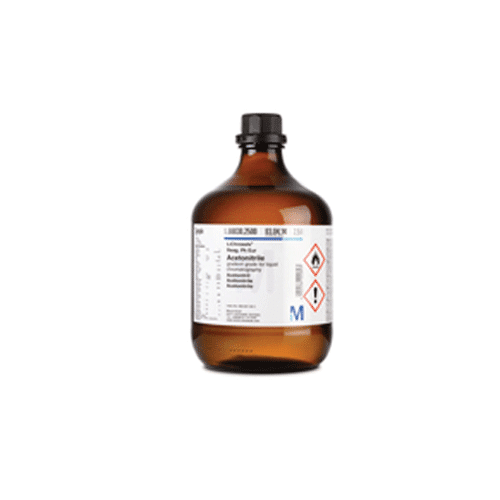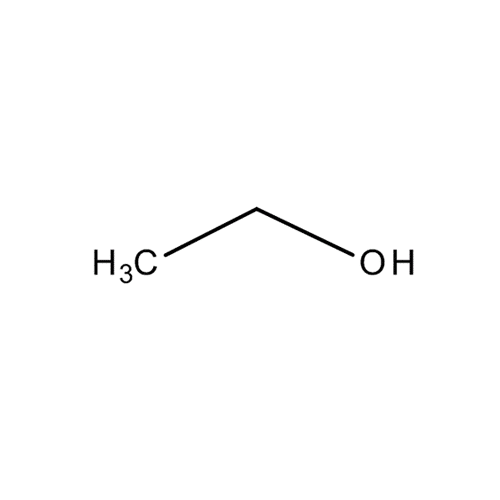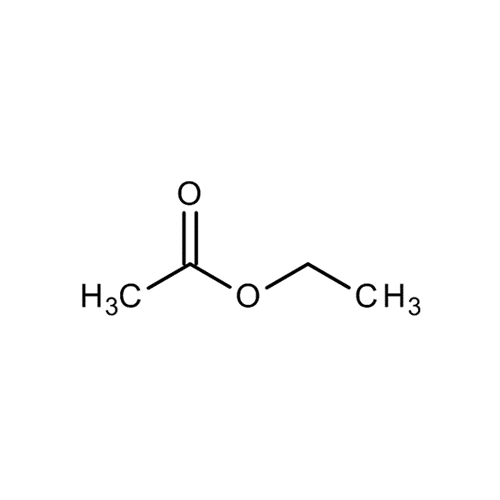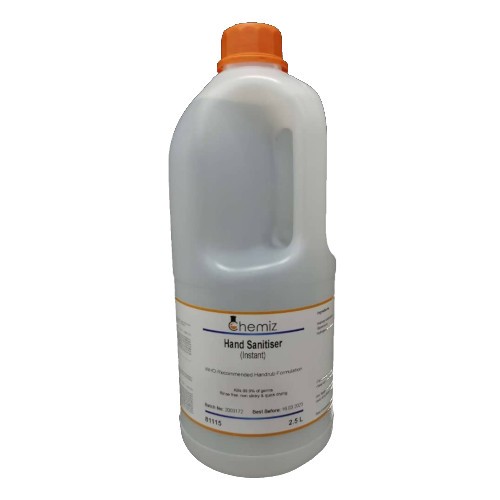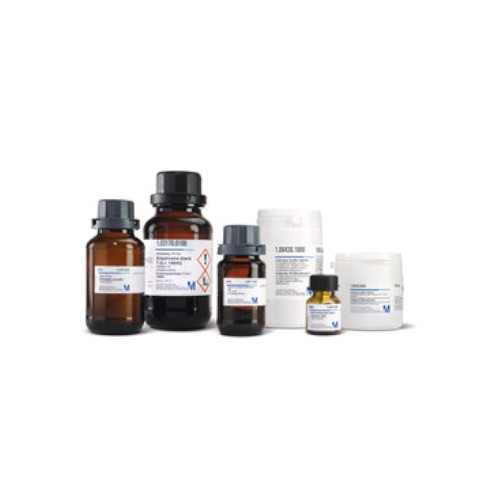
DPPH, Free Radical (Merck)
Login to see pricesBrand:
Merck
Description
CAS number: 1898-66-4
Linear Formula: C₁₈H₁₂N₅O₆
Purity: ≥90% by elemental analysis
DPPH, Merck is a cell-permeable, stable free radical that acts as a hydrogen radical scavenger. Useful in inducing free-radical injury to tissues and as a screening tool for detecting free radical scavenging activity of antioxidants. Absorption max: ~517 nm. Protect the DPPH from light.
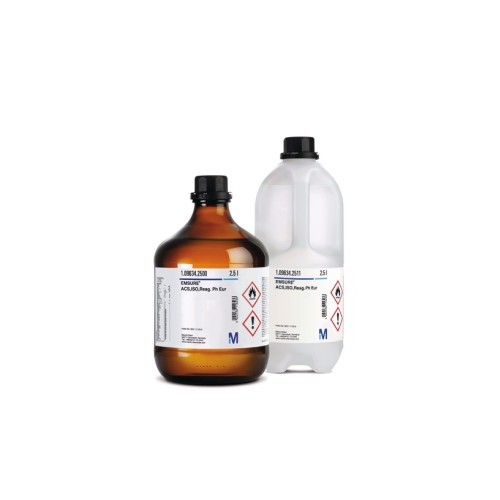
Ethanol denatured with about 1% methyl ethyl ketone for analysis EMSURE® (Merck)
Login to see pricesBrand:
Merck
Description
CAS number: 64-17-5
Chemical Formula: C₂H₅OH
Molar Mass: 46.07 g/mol
Synonyms: Ethyl alcohol, EtOH
EMSURE® grade solvents are suitable for a broad spectrum of classical lab applications and are frequently used in regulated and highly demanding lab applications. EMSURE® provides worldwide best and most extensive product specifications. We declare our EMSURE® range to be in compliance with the ACS, with the reagent part of the European Pharmacopoeia (Reag. Ph Eur) and also with the ISO standards.
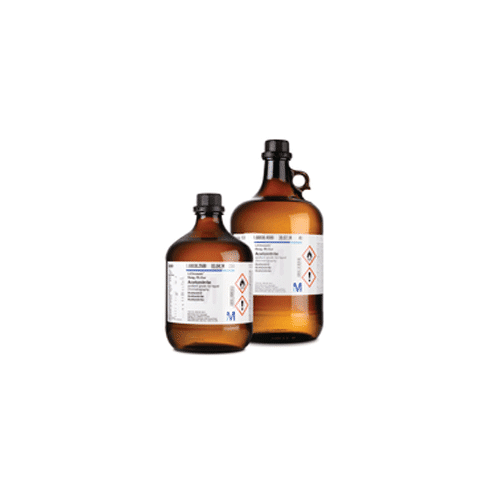
Ethanol for Molecular Biology (Merck)
Login to see pricesBrand:
Sigma-Aldrich
Description
CAS number: 64-17-5
Linear Formula: C₂H₅OH
Molecular Weight 46.07
Synonym: Ethyl alcohol, EtOH
Application
Ethanol for molecular biology.
Ethanol gradient grade for liquid chromatography LiChrosolv®
Login to see pricesBrand:
Merck
Description
CAS number: 64-17-5
Chemical Formula: C₂H₅OH
Molar Mass: 46.07 g/mol
Synonyms: Ethyl alcohol, EtOH
With their high degree of UV transmittance, low particle count, low acidity and alkalinity and low evaporation residue level, LiChrosolv® solvents are ideal for reproducible separations. Since separations are normally carried out under gradient conditions in analytical HPLC, we offer solvents in “gradient grade” as well as “isocratic grade”. This enables to minimize the gradient effect of the solvent involved. Filtered by 0.2 µm filter
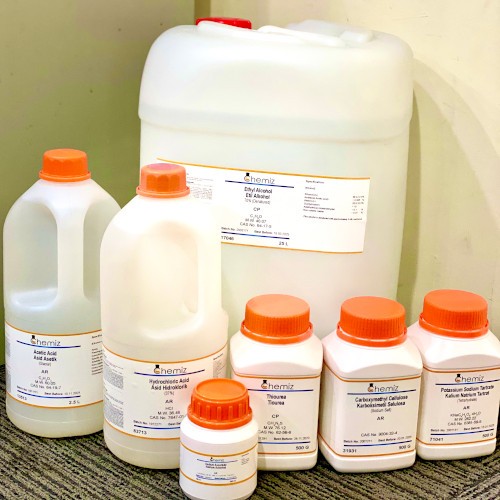
Ethyl acetate AR, 2.5L
Login to see pricesBrand:
Chemiz
Description
Synonyms: Ethyl ester
Formula: C4H8O2
Analytical reagent grade ethyl acetate for laboratory uses in quantitative or qualitative analytical work.
Note:
AR: Analitycal Reagent Grade: Reagents for analytical purpose or research work that need high purity.
CP: Chemically Pure Grade: Reagents for regular practical in its original purity.

Ethyl Acetate for analysis EMSURE® ACS,ISO,Reag. Ph Eur (Merck)
Login to see pricesBrand:
Merck
Description
CAS number: 141-78-6
Linear Formula: CH₃COOC₂H₅
Molecular Weight: 88.11 g/mol
Synonym: Ethyl ethanoate, Acetic ester, Ethyl ester
Description
EMSURE® grade solvents are suitable for a broad spectrum of classical lab applications and are frequently used in regulated and highly demanding lab applications. EMSURE® provides worldwide best and most extensive product specifications. We declare our EMSURE® range to be in compliance with the ACS, with the reagent part of the European Pharmacopoeia (Reag. Ph Eur) and also with the ISO standards.
Ethyl acetate for liquid chromatography LiChrosolv®
Login to see pricesBrand:
Merck
Description
CAS number: 141-78-6
Chemical Formula: CH₃COOC₂H₅
Molar Mass: 88.11 g/mol
Synonyms: Ethyl ethanoate, Acetic ester, Ethyl ester
With their high degree of UV transmittance, low particle count, low acidity and alkalinity and low evaporation residue level, LiChrosolv® solvents are ideal for reproducible separations. Since separations are normally carried out under gradient conditions in analytical HPLC, we offer solvents in “gradient grade” as well as “isocratic grade”. This enables to minimize the gradient effect of the solvent involved. Filtered by 0.2 µm filter

Ethyl Methyl Ketone for Analysis EMSURE® ACS,Reag. Ph Eur (Merck)
Login to see pricesBrand:
Merck
Description
CAS Number: 78-93-3
Chemical Formula: C₂H₅COCH₃
Molecular Weight: 72.11 g/mol
Synonyms: 2-Butanone, Methyl ethyl ketone, MEK
Quality Level: MQ300
Product Specification and MSDS for ethyl methyl ketone (Merck).
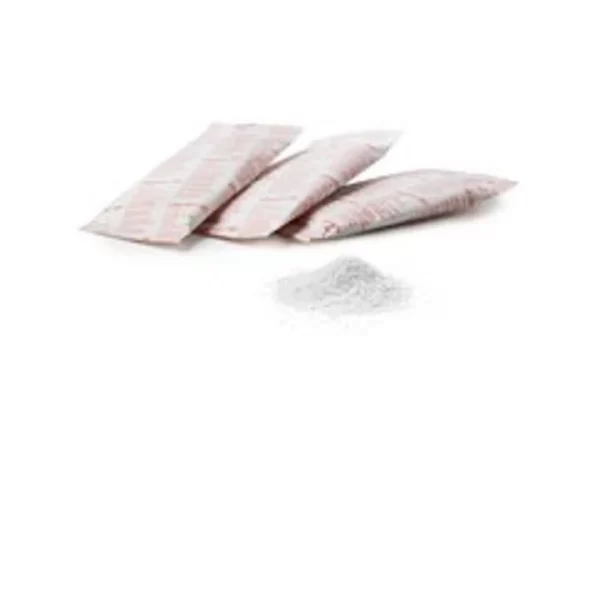
EXtrelut® NT Refill pack for column fillings EXtrelut® NT 20 (Merck)
Login to see pricesBrand:
Merck
Description:
CAS Number : 68855-54-9
Extrelut® NT simplifies liquid-liquid extraction in its most effective form by using a chemically inert, wide-pore and highly pure diatomaceous earth based solid phase. Depending on the sample volume three types of columns are available: Extrelut® NT1 can take up a maximum of one ml, Extrelut® NT3 three ml and Extrelut® NT20 up to twenty ml of sample.
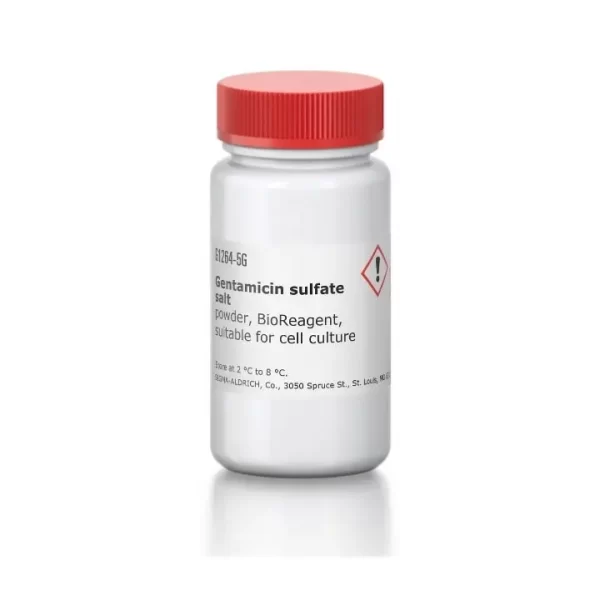
Gentamicin sulfate salt – Sigma-Aldrich
Login to see pricesBrand:
Sigma
Description
Cas Number : 1045-41-0
Synonyms : Gentiomycin C
Chemical structure: aminoglycoside
Gentamicin, also known as gentiomycin C, is an aminoglycoside, which is naturally produced by Gram-negative bacteria. This antibiotic functions by preventing protein synthesis.[1] Gentamicin sulfate prevents the growth of both Gram positive and Gram negative bacteria, in vivo and in vitro. In tissue culture, gentamicin sulfate is used to inhibit the growth of various strains of mycoplasma.[2].
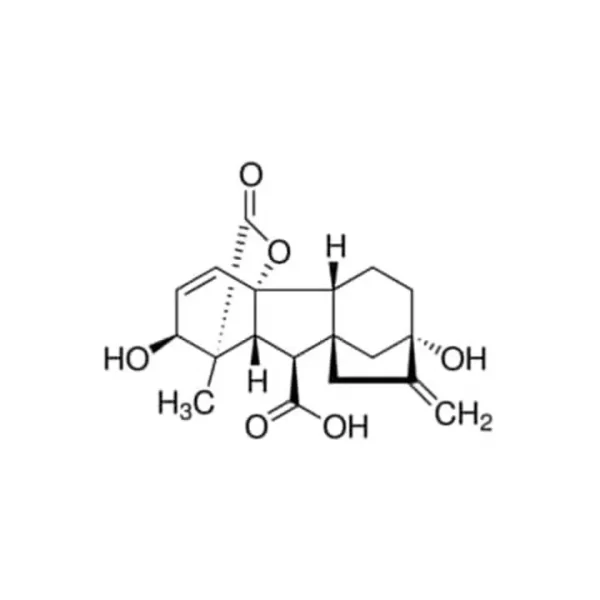
Gibberellin 80% gibberellin A3 basis (TLC) (Sigma-Aldrich)
Login to see pricesBrand:
Sigma
Description
Formula : C19H22O6
Molecular weight : 346.37 g/mol
Synonym : GA3
A “classical” ubiquitous plant hormone, with diverse effects, such as stilumating stem and root growth, and stimulating seed germination.

Giemsa’s Azur Eosin Methylene Blue Solution (Merck) – Discontinued
Login to see pricesBrand:
Merck
**This product has been discontinued, please contact us for more information.
Description
The Giemsa’s Azure Eosin Methylene Blue solution can be used for the staining of blood and bone marrow smears, paraffin sections and clinical-cytological specimens. Giemsa staining is one of the standard procedures in histology, demonstrating various cells with their morphological features better than with H&E stain. The Giemsa stain can also be used to detect Helicobacter pylori in gastric tissue biopsies. The specimen material will show cell nuclei stained in various shades of blue, while other structures will appear in various red types. It is an IVD product and CE registered.
Application
For microscopy. For the staining of blood and bone-marrow smears, paraffin sections and clinical-cytological specimens
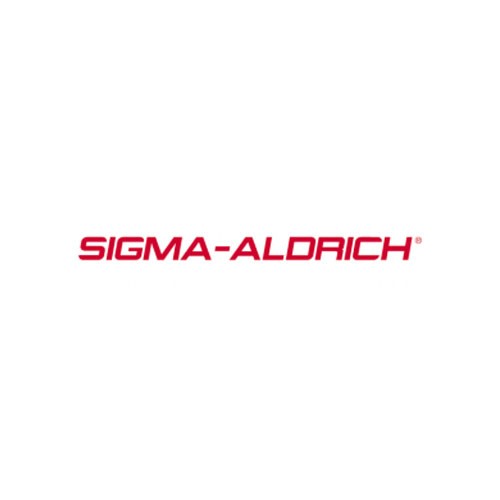
Glutathione, Certified Reference Material (Sigma-Aldrich)
Login to see pricesBrand:
Sigma-Aldrich
Description
CAS number: 70-18-8
Chemical Formula: H2NCH(CO2H)CH2CH2CONHCH(CH2SH)CONHCH2CO2H
Molar Mass: 307.32g/mol
Synonyms: γ-L-Glutamyl-L-cysteinyl-glycine, L-Glutathione reduced, GSH
Amino Acid Sequence
γ-Glu-Cys-Gly
General description
Glutathione (GSH) is the most important nonprotein thiol widely distributed in animal tissues, plants, and microorganisms. GSH is also a key determinant of redox signalling and protection against oxidative stress.
Pharmaceutical secondary standards for application in quality control, provide pharma laboratories and manufacturers with a convenient and cost-effective alternative to the preparation of in-house working standards.
Application
HPLC: suitable
Gas Chromatography (GC): suitable
These Secondary Standards are qualified as Certified Reference Materials. These are suitable for use in several analytical applications including but not limited to pharma release testing, pharma method development for qualitative and quantitative analyses, food and beverage quality control testing, and other calibration requirements.
May be used at 5-10 mM to elute glutathione S-transferase (GST) from glutathione agarose.
Biochem/physiol Actions
Endogenous antioxidant that plays a major role in reducing reactive oxygen species formed during cellular metabolism and the respiratory burst. Glutathione-S-transferase catalyzes the formation of glutathione thioethers with xenobiotics, leukotrienes, and other molecules that have an electrophilic center. Glutathione also forms disulfide bonds with cysteine residues in proteins. Via these mechanisms, it can have the paradoxical effect of reducing the efficacy of anti-cancer agents.

Glycerol (Glycerine) AR, 2.5L
Login to see pricesBrand:
Chemiz
Description
Synonyms: Glycerine
Formula: C3H8O3
Analytical reagent grade glycerol for various laboratory uses including gel formation for polyacrylamide gel, altering density of liquids and prevention of freezing for certain samples when stored.
Note:
AR: Analitycal Reagent Grade: Reagents for analytical purpose or research work that need high purity.
CP: Chemically Pure Grade: Reagents for regular practical in its original purity.

Glycerol, For Molecular Biology, ≥99.0% (Sigma-Aldrich)
Login to see pricesBrand:
Sigma-Aldrich
Description
CAS number: 56-81-5
Chemical Formula: HOCH2CH(OH)CH2OH
Molar Mass: 92.09 g/mol
Synonyms: 1,2,3-Propanetriol, Glycerin
General description
Glycerol is odourless, colourless, viscous in nature, and exists as a sweet-tasting liquid. It can be derived naturally as well as from petrochemical feedstock. Glycerol has a wide variety of applications and is one of the most valuable and versatile chemical substances in nature. It can be used as an emollient, solvent, sweetening agent, in pharmaceutical formulations, cosmetics, foodstuffs and toiletries. It is very stable and can be easily stored under normal temperature; also it is non-irritating and has no adverse impact on the environment.
Application
Glycerol has been used as:
• A supplement during cell culture of Mycobacterium tuberculosis and Mycobacterium avium.
• A fuel during designing enzymatic biofuel cell.
• A liquid composite matrix with 4-HCCA and 3-aminoquinoline for analysis of neutral and acidic glycans.
• A matrix for fast atom bombardment MS.
• May be employed as liquid matrix for the quantification studies by MALDI (Matrix-assisted laser desorption/ionization mass spectrometry) analysis.
Glycerol is used both in sample preparation and gel formation for polyacrylamide gel electrophoresis. Glycerol (5-10%) increases the density of a sample so that the sample will layer at the bottom of a gel′s sample well. Glycerol is also used to aid in casting gradient gels and as a protein stabilizer and storage buffer component.
Glycerol is used both in sample preparation and gel formation for polyacrylamide gel electrophoresis. Glycerol (5-10%) increases the density of a sample so that the sample will layer at the bottom of a gel’s sample well. Glycerol is also used to aid in casting gradient gels and as a protein stabilizer and storage buffer component.

Glycine AR, 500g
Login to see pricesBrand:
Chemiz
Description
Synonyms: 2-Aminoacetic acid
Formula: C2H5NO2
Glycine is an important component for some solution used in polyacrylamide gel electrophoresis method in protein analysis, acting as buffer to maintain pH level to prevent damage to the sample during analysis.
Note:
AR: Analitycal Reagent Grade: Reagents for analytical purpose or research work that need high purity.
CP: Chemically Pure Grade: Reagents for regular practical in its original purity.
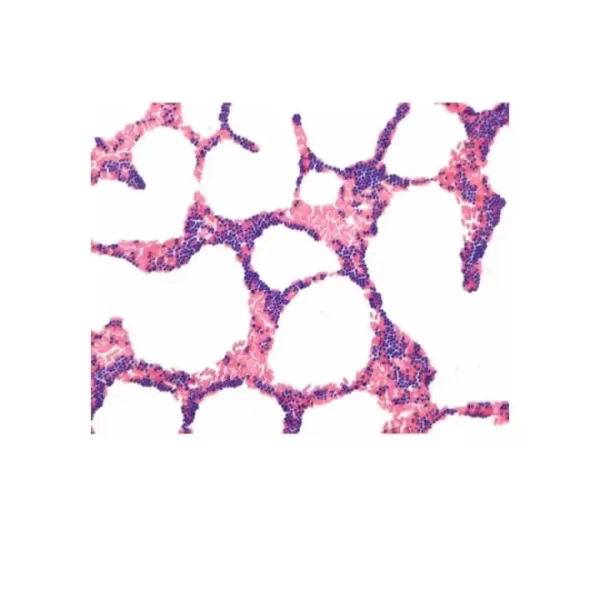
Gram-Color Stain set for the Gram staining method-Merck
Login to see pricesBrand:
Merck
Description
Gram-Color – stain set for the Gram staining method, is used for human-medical cell diagnosis and serves the purpose of the bacteriological investigation of sample material of human origin, for example smears of body fluids. The Gram-Color solutions are modified and designed in such a way that staining can be carried out in staining cells, on the staining rack, and also in automated staining systems. Gram-color modified, phenol-free is a staining set for staining microorganisms. Aniline dyes in the cell tissue of microorganisms form a red dye-iodine complex when exposed to iodine. Sodium hydrogen carbonate enhances the formation of this complex further still. In gram-positive microorganisms the dye-iodine complex cannot be subsequently dissolved from the cells by decolorizing agents such as alcohol or acetone. The cell remains dark blue in color. In gram-negative microorganisms the dye-iodine complex is dissolved and the cell turns red as a result of counterstaining with fuchsin. Gram-color modified, phenol-free is an IVD / CE product.
The package is sufficient for 250 applications. For further information, please see the IFU which can be found in the kit.
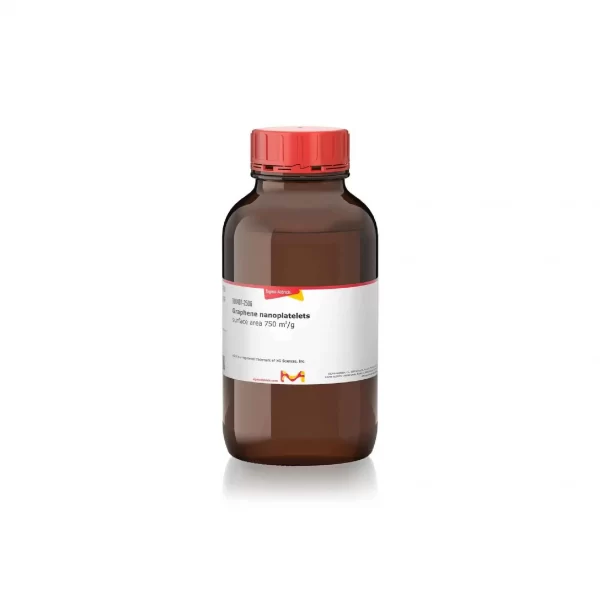
Graphene Nanoplatelets, Sigma – Aldrich
Login to see pricesBrand:
Sigma
Description
CAS number: 7782-42-5
Molecular weight:12.01
Synonyms: GNPs, xGnP® graphene nanoplatelets-grade C-750
xGnP® graphene nanoplatelets are a unique type of nanoparticle that have a platelet shape and are composed of short stacks of graphene sheets. Their distinctive size and morphology make them highly effective at providing barrier properties, as well as excellent electrical and thermal conductors due to their pure graphitic composition. Additionally, incorporating xGnP® graphene nanoplatelets can enhance mechanical properties such as stiffness, strength, and surface hardness of the matrix material.
Applications include:
- Ultracapacitor electrodes.
- Anode materials for lithium-ion batteries.
- Conductive additive for battery electrodes.
- Electrically conductive inks.
- Thermally conductive films and coatings.
- Additive for lightweight composites.
- Films or coatings for EMI shielding.
- Substrate for chemical and biochemical sensors.
- Barrier material for packaging.
- Additive for super-strong concrete.
- Additive for metal-matrix composites.
Hand Sanitizer
Login to see pricesBrand:
Chemiz
Description
Hand sanitiser is prepared according to the WHO Recommended Handrub Formulation.
Kills 99.9% of germs. Rinse free, non-sticky and quick drying.

Histopaque®-1077 (Sigma-Aldrich)
Login to see pricesBrand:
Sigma-Aldrich
General description
Histopaque-1077 is a sterile, endotoxin tested solution of polysucrose and sodium diatrizoate, adjusted to a density of 1.077g/mL. This ready-to-use medium facilitates rapid recovery of viable lymphocytes and other mononuclear cells from small volumes of whole blood.
Application
Haematology: suitable
Histology: suitable
Histopaque-1077 has been used for-
• the isolation of peripheral blood mononuclear cells (PBMCs) and bone marrow mononuclear cells (BMMCs)
• purification of mononuclear cells through centrifugation
• isolation of human lymphocytes
• isolation of breast cancer circulating tumour cells (CTCs) from whole blood

Hydrochloric acid 2% w/v solution, 1L
Login to see pricesBrand:
Chemiz
Description
Synonyms: Hydrogen Chloride
Formula: HCl
Hydrochloric acid 2% w/v solution is a clear liquid with highly corrosive property and pungent smell. It is unlikely to subject to oxidation-reduction reaction. This strong monoprotic acid reacts with basic compound to dissolve the chlorides for analysis.

Hydrogen peroxide 30%, AR, 2.5L
Login to see pricesBrand:
Chemiz
Description
Synonyms: Bleach
Formula: H2O2
Hydrogen Peroxide is a strong oxidizer thus considered as a highly reactive oxygen species. This weak acid can form hydroperoxide or peroxide salts.
Note:
AR: Analitycal Reagent Grade: Reagents for analytical purpose or research work that need high purity.
CP: Chemically Pure Grade: Reagents for regular practical in its original purity.
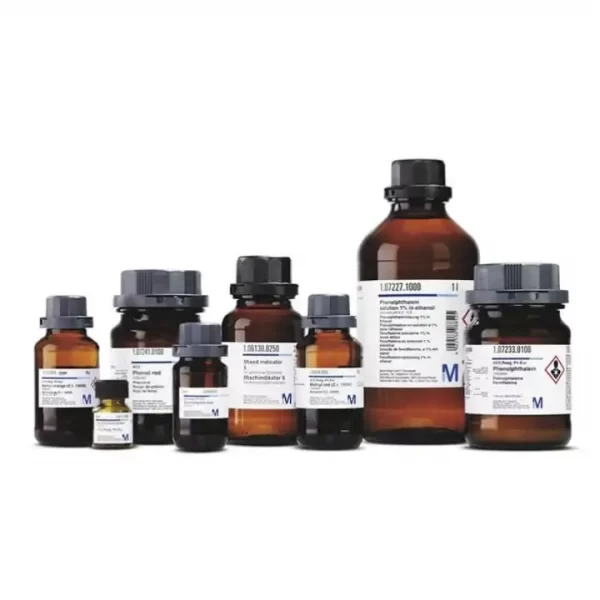
Hydroxynaphthol blue metal (pM) indicator (Merck)
Login to see pricesBrand:
Merck
Description
Cas Number : 63451-35-4
Molar mass : 620.47 g/mol
Chemical formula : : : C₂₀H₁₁N₂Na₃O₁₁S₃
Synonyms : 2,2′-Dihydroxy-1,1′-azonaphthalene-3′,4,6′-trisulfonic acidtrisodiumsalt.
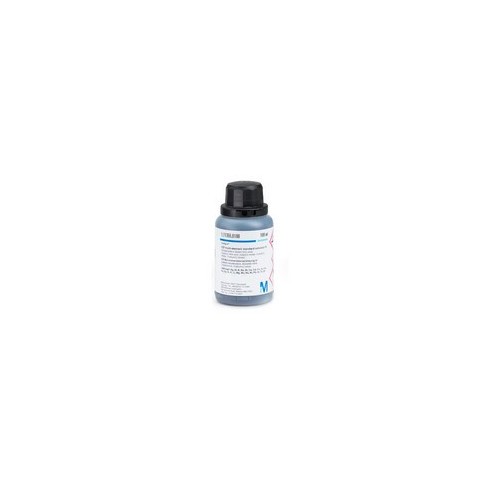
ICP multi-element standard solution IV (Merck)
Login to see pricesBrand:
Merck
CAS no.: 10421-48-4, 10124-37-5, 10022-31-8, 10141-05-6, 13548-38-4, 10377-66-9, 10377-60-3, 10099-74-8, 13473-90-0, 69365-72-6, 7790-69-4, 7697-37-2, 7761-88-8, 13770-61-1, 10042-76-9, 7631-99-4, 7757-79-1, 3251-23-8, 13138-45-9, 10102-45-1, 10361-44-1, 10325-94-7, 7779-88-6, 10043-35-3
No. of Elements: 23 elements in diluted nitric acid 1000 mg/l
Elements in the Standard: Ag, Al, B, Ba, Bi, Ca, Cd, Co, Cr, Cu, Fe, Ga, In, K, Li, Mg, Mn, Na, Ni, Pb, Sr, Tl, Zn Certipur®
Synonym: Nota 1 A
Quality level: MQ100
Product specification and SDS for ICP multi-element standard solution IV.

